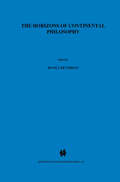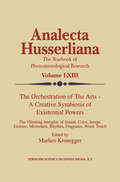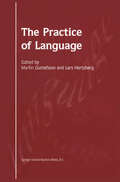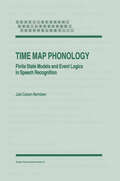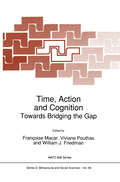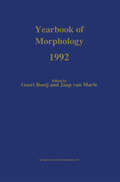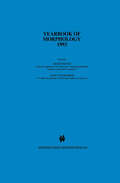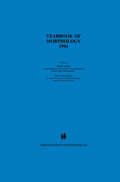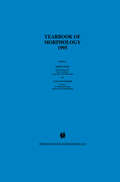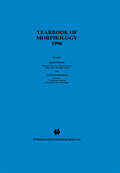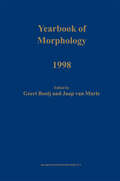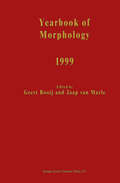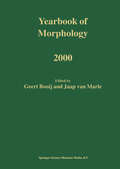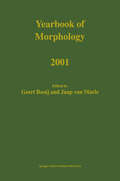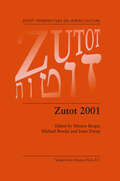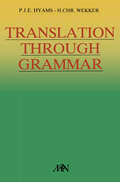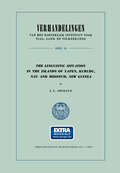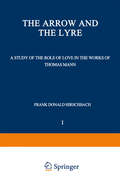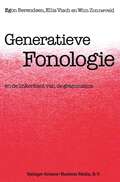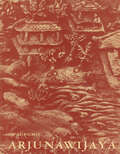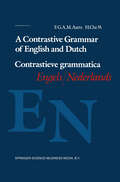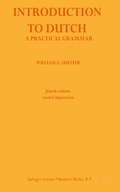- Table View
- List View
The Horizons of Continental Philosophy: Essays on Husserl, Heidegger, and Merleau-Ponty (Martinus Nijhoff Philosophy Library #30)
by Hugh J. Silverman, Algis Mickunas, Theodore Kisiel and Alphonso Lingislacan. Barthes. Jakobson. Horkheimer. Adorno. Gadamer. Ricoeur. Foucault. Deleuze. Derrida. lyotard. Vattimo. Kofman. and Irigaray are also part of that outer horizon of continental philosophy. The purpose of this volume however is to establish that space within the core of continental philosophy - specifically in relation to the work of Husserl. Heidegger. and Merleau-Ponty -- and to move out to some of its various horizons. In some cases. these horizons are set by the history of philosophy. in others by newer directions in contemporary philosophy. and in others by alternative modes of philosophizing. The horizons also appear in areas as diverse as epistemology and the philosophy of science. metaphysics. philosophical psychology. and aesthetics. Furthermore. these limits are set by the relationships between philosophy and other disciplines such as psychology. communication theory. and the arts. Nevertheless the volume is organized around each of the three major figures in the phenomenological core of continental philosophy. The twelve essays provide important investigations into current research -- they represent the range and skills of contemporary work in relation to Husserl. Heidegger. and Merleau-Ponty. In themselves however they indicate advances in philosophical research and are hardly simple commentaries on these three figures. Husserl. Heidegger. and Merleau-Ponty constitute texts on the basis of which phenomenology is taken to its limits -- and even beyond.
The Orchestration of the Arts — A Creative Symbiosis of Existential Powers: The Vibrating Interplay of Sound, Color, Image, Gesture, Movement, Rhythm, Fragrance, Word, Touch (Analecta Husserliana #63)
by MarliesKroneggerRegardless of the subject matter, our studies are always searching for a sense of the universal in the specific. Drawing, etchings and paintings are a way of communicating ideas and emotions. The key word here is to communicate. Whether the audience sees the work as laborious or poetic depends on the creative genius of the artist. Some painters use the play of light passing through a landscape or washing over a figure to create an evocative moment that will be both timeless and transitory. The essential role of art remains what is has always been, a way of human expression. This is the role that our participants concentrate on as they discuss art as the expression of the spirit, a creative act through which the artist makes manifest what is within him. Spirit suggests the unity of feeling and thought. Avoiding broad generalities, our participants address specific areas in orchestration with music, architecture, literature and phenomenology. Profs. Souiller, Scholz, Etlin, Sweetser, Josephs show us at what point art is an intimate, profound expression and the magic of a civilization as a whole, springing from its evolving thoughts and embodying ideals, such as the Renaissance, the Baroque, Modernism and at what point it reflects the trans formation of a particular society and its mode of life.
The Poetry of Life in Literature (Analecta Husserliana #69)
by Anna-TeresaTymienieckaPoetry of life in literature and through literature, and the vast territory in between - as vast as human life itself - where they interact and influence each other, is the nerve of human existence. Whether we are aware of it or not, we are profoundly dissatisfied with the stark reality of life's swift progress onward, and the enigmatic and irretrievable meaning of the past. And so we dramatise our existence, probing deeply for a lyrical and heartfelt yet universally valid sense of our experience. It is in great works of literature that we seek those hidden springs that so move us. It is in honour of this search that this collection focuses on the creative imagination at work in literature and aesthetics.
The Practice of Language
by Martin GustafssonThis book shows that philosophers and linguists of quite different brands have tended to give undue priority to their own favorite theoretical framework, and have presupposed that the descriptive scheme invoked by that framework constitutes a pattern to which any linguistic practice somehow has to conform. United by a critical attitude towards such essentialist aspirations, the authors collectively manage to cast doubt on the very attempt to fit the whole of linguistic practice into a general theoretical mould.
Time Map Phonology: Finite State Models and Event Logics in Speech Recognition (Text, Speech and Language Technology #5)
by J. Carson-BerndsenThis book is a revised version of my doctoral thesis which was submitted in April 1993. The main extension is a chapter on evaluation of the system de scribed in Chapter 8 as this is clearly an issue which was not treated in the original version. This required the collection of data, the development of a concept for diagnostic evaluation of linguistic word recognition systems and, of course, the actual evaluation of the system itself. The revisions made primarily concern the presentation of the latest version of the SILPA system described in an additional Subsection 8. 3, the development environment for SILPA in Sec tion 8. 4, the diagnostic evaluation of the system as an additional Chapter 9. Some updates are included in the discussion of phonology and computation in Chapter 2 and finite state techniques in computational phonology in Chapter 3. The thesis was designed primarily as a contribution to the area of compu tational phonology. However, it addresses issues which are relevant within the disciplines of general linguistics, computational linguistics and, in particular, speech technology, in providing a detailed declarative, computationally inter preted linguistic model for application in spoken language processing. Time Map Phonology is a novel, constraint-based approach based on a two-stage temporal interpretation of phonological categories as events.
Time, Action and Cognition: Towards Bridging the Gap (NATO Science Series D: #66)
by William J. Friedman VivianePouthas FrançoiseMacarThis volume is the outcome of the NATO Advanced Research Workshop on Time, Action and Cognition. which was held in Saint-Malo, France, in October 1991. The theme - time in action and cognition of time - was sparked by growing awareness in informal meetings between mostly French-speaking time psychologists of the need to bring together time specialists in the areas of development, motor behavior, attention, memory and representations. The workshop was designed to be a forum where different theoretical points of view and a variety of empirical approaches could be presented and discussed. Time psychologists tended to draw conclusions restricted to their specific fields of interest. From our own experience, we felt that addressing a common issue - possible relationships between time in action and representations of time - could lead to a more comprehensive approach. We are endebted to NATO for allowing us to bring this idea to fruition. We take this opportunity as well to express our thanks to Cognisciences ( Cognisud section) -- an active interdisciplinary research organization - for its financial backing and the CNRS for its scientific support.
Yearbook of Morphology 1992 (Yearbook of Morphology)
by Geert Booij Jaap Van MarleA revival of interest in morphology has taken place during recent years and the subject is seen now as a relatively autonomous subdiscipline of linguistics. As one of the important areas of theoretical research in formal linguistics, morphology has attracted linguists to investigate its relations to syntax, semantics, phonology, psycholinguistics and language change. The aim of the Yearbook of Morphology, therefore, is to support and enforce the upswing of morphological research and to give an overview of the current issues and debates at the heart of this revival.
Yearbook of Morphology 1993 (Yearbook of Morphology)
by Geert Booij Jaap Van MarleRecent years have seen a revival of interest in morphology. The Yearbook of Morphology series supports and enforces this upswing of morphological research and gives an overview of the current issues and debates at the heart of this revival. The Yearbook of Morphology 1993 focuses on prosodic morphology, i.e. the interaction between morphological and prosodic structure, on the semantics of word formation, and on a number of related issues in the realm of inflection: the structure of paradigms, the relation between inflection and word formation, and patterns of language change with respect to inflection. There is also discussion of the relevance of the notion `level ordering' for morphological generalizations. All theoretical and historical linguists, morphologists, and phonologists will want to read this volume.
Yearbook of Morphology 1994 (Yearbook of Morphology)
by Geert Booij Jaap Van MarleRecent years have seen a revival of interest in morphology. The Yearbook of Morphology series supports and enforces this upswing of morphological research and gives an overview of the current issues and debates at the heart of this revival. The Yearbook of Morphology 1994 focuses on prosodic morphology, i.e. the interaction between morphological and prosodic structure, on the semantics of word formation, and on a number of related issues in the realm of inflection: the structure of paradigms, the relation between inflection and word formation, and patterns of language change with respect to inflection. There is also discussion of the relevance of the notion `level ordering' for morphological generalizations. All theoretical and historical linguists, morphologists, and phonologists will want to read this book.
Yearbook of Morphology 1995 (Yearbook of Morphology)
by JaapMarle GeertBooijA revival of interest in morphology has occurred during recent years. The aim of the Yearbook of Morphology series is to support and enforce this upswing of morphological research and to give an overview of the current issues and debates at the heart of this revival. The Yearbook of Morphology 1995 focuses on an important issue in the current morphological debate: the relation between inflection and word formation. What are the criteria for their demarcation, in which ways do they interact and how is this distinction acquired by children? The papers presented here concur in rejecting the `split morphology hypothesis' that claims that inflection and word formation belong to different components of the grammar. This volume also deals with the marked phenomenon of subtractive morphology and its theoretical implications. Theoretical and historical linguists, morphologists, phonologists and psycholinguists interested in linguistic issues will find this book of interest.
Yearbook of Morphology 1996 (Yearbook of Morphology)
by JaapMarle GeertBooijA revival of interest in morphology has occurred during recent years. Since 1988, the Yearbook of Morphology book series has proven to be an eminent platform for the growth of morphological research, containing articles on topics that are central in the current theoretical debates. The Yearbook of Morphology 1996 focuses on the relationship between morphology and psycholinguistics. Basic questions such as the following are discussed. To what extent does the morphological structure of a word play a role in its perception and production? Are regular complex words created anew each time they are used, or are they stored in the lexicon? The relevant evidence comes from a variety of European languages. Another important theme in this yearbook is the degree of autonomy of morphology: in which respect does it differ from other modules of the grammar? The present yearbook also contains articles on periphrasis, the nature of inflectional morphology and syncretism in derivational morphology. Audience: Theoretical and historical linguists, morphologists, phonologists and psycholinguists will find this book of interest.
Yearbook of Morphology 1998 (Yearbook of Morphology)
by G. E. Booij Jaap Van MarleA revival of interest in morphology has occurred during recent years. The Yearbook of Morphology series, published since 1988, has proven to be an eminent support for this upswing of morphological research, since it contains articles on topics which are central in the current theoretical debates which are frequently referred to. The Yearbook of Morphology 1998 focuses on two issues: the position of inflection in the grammar, and the interaction of morphology with phonology, in particular the problem of allomorphy. In addition, this volume presents a study of the relation between transposition and argument structure, a declarative model of word formation applied to conversion in German, an analysis of Dutch verbal compounds and a study of the semantic aspects of nominalization. The relevant evidence comes from a wide variety of languages. Theoretical, descriptive, and historical linguists, morphologists, phonologists, and psycholinguists will find this book of interest.
Yearbook of Morphology 1999 (Yearbook of Morphology)
by JaapMarle GeertBooijA revival of interest in morphology has occurred during recent years. The Yearbook of Morphology series, published since 1988, has proven to be an eminent support for this upswing of morphological research, since it contains articles on topics which are central in the current theoretical debates which are frequently referred to. The Yearbook of Morphology 1999 focuses on diachronic morphology, and shows, in a number of articles by renowned specialists, how complicated morphological systems develop in the course of time. In addition, this volume deals with a number of hotly debated issues in theoretical morphology: its interaction with phonology (including Optimality Theory), the relation between inflection and word formation, and the formal modeling of inflectional systems. A special feature of this volume is an article on morphology in sign language, a very new and exciting area of research in linguistics. The relevant evidence comes from a wide variety of languages, amongst which Germanic, Romance, and Slavic languages are prominent. Audience: Theoretical, descriptive, and historical linguists, morphologists, phonologists, and psycholinguists will find this book of interest.
Yearbook of Morphology 2000 (Yearbook of Morphology)
by G. E. Booij Jaap Van MarleA revival of interest in morphology has occurred during recent years. The Yearbook of Morphology series, published since 1988, has proven to be an eminent support for this upswing of morphological research, since it contains articles on topics which are central in the current theoretical debates which are frequently referred to. The Yearbook of Morphology 2000 focuses on the relation between morphology and syntax. First, a number of articles is devoted to the ways in which morphological features can be expressed in the grammar of natural languages, both by morphological and syntactic devices. This also raises the more general issue of how we have to conceive of the relation between form and (grammatical) meaning. Several formalisms for inflectional paradigms are proposed. In addition, this volume deals with the demarcation between morphology and syntax: to which extent can syntactic principles and generalizations be used for a proper account of the morphology of a language? The languages discussed are Potawatomi, Latin, Greek, Romanian, West-Greenlandic, and German. A special feature of this volume is a section devoted to the analysis of the morphosyntax of a number of Austronesian languages, which are also relevant for deepening our insights into the relation between our morphology and syntax. Audience: Theoretical, descriptive, and historical linguists, morphologists, phonologists, computational linguists, and psycholinguists will find this book of interest.
Yearbook of Morphology 2001 (Yearbook of Morphology)
by JaapMarle GeertBooijThe Yearbook of Morphology 2001 focuses on the notion of productivity, the role of analogy in coining new words, and constraints on affix ordering in a number of Germanic languages are investigated. Other topics include the necessity and the role of the paradigm in morphological analyses, the relation between form and meaning in morphology, the accessibility of the internal morphological structure of complex words, and the interaction of morphology and prosody in truncation processes.
Zutot 2001 (Zutot: Perspectives on Jewish Culture #1)
by IreneZwiep MichaelBrocke ShlomoBergerThe 2001 yearbook aims to fill a gap that has become more and more conspicuous among the wealth of scholarly periodicals in the field of Jewish Studies. It covers Jewish Culture in its broadest sense, i.e. encompassing various academic disciplines - literature, languages and linguistics, philosophy, art, sociology, politics and history - and reflects binary oppositions such as religious and secular, high and low, written and oral, male and female culture.
Translation through grammar: A graded translation course, with explanatory notes and a contrastive grammar
by P. J. Hyams H. Chr. WekkerAlltranslation is a compromise-the effort to be literal and the e. ffort to be idiomatic BenjaminJowett (1817-93) This book is designed to provide intermediate and advanced students of English with practice in the translation ofDutch texts into English. It contains fifty prose passages, most of them taken from recent Dutch novels or journals, all of them tried out on several generations of our own students in the 'pre-kandidaatsfase' of their studies at the English Department of the University of Nijmegen. In these respects, it is not spectacularly different from many other books ofits kind. We have, however, tried to offer the student rather more support in his translation work than is usually clone: each text is provided with a suggested translation of the first few lines and with notes containing information on grammar and idiom, sometimes preceded by supplementary material from British or American sources. The second part of the book comprises a short contrastive grammar speciallywritten to meet theneeds oftheuser. In this way wehope to offer a self-contained translation course which reinforces the interdependence of grammar, vocabulary, textual interpretation and style. Most ofthe texts in this book are reproduced in substantially the sameform and wording as in the original sources. In some cases editing was necessary in order, for example, to reduce long articles to more manageable proportions. In no cases, however, were we moved to doctor the originals in order to disambiguate them or to make them easier to translate.
The Linguistic Situation in the Islands of Yapen, Kurudu, Nau and Miosnum, New Guinea (Verhandelingen van het Koninklijk Instituut voor Taal-, Land- en Volkenkunde)
by J. C. Anceaux2. The Sources 3 3. The Language Map . 6 4. The Comparative Word-List. 13 5. The quantitative Analysis . 80 6. Phonological Relationships 149 7. Verbal Forms . 150 8. Elements for indicating personal possession of the parts of the body. . . . . . . . . 157 . 9. Elements to indicate possession with regard to kinship terms . . . . . . . 163 Language Map at the end of the volume. -----------,, ..... --------- ', .......... A ' ~~ \ ~~ ~ \ \ .......... e· ., .. c. \ A-Biak '',, _____________ _ ,, ---~-' B-Waropen ............... ~ ---------- ~--- C-Mor D-Wandamen ~ E-Dusner f. Ron G-Meoswar Geelvink Bay H -lrarutu ...... , .......... ..... , ..... I ' " I I 0 I Sketch Map I I I ,-----; I \ \~_/\ ' of the H 11~£W~ I I \ \. 1,_'8_} n / r ';!?;' r ' • Geelvink Bay Area (Scale 1 : 2.350.000) Indicated are the areas of the languages used for comparison.
The Arrow and the Lyre: A Study of the Role of Love in the Works of Thomas Mann (International Scholars Forum #1)
by Frank Donald HirschbachWhen I first thought about this topic I encountered many ex pressions of surprise among my better-read friends, and a number of them asked me: "Is there really much love in Thomas Mann's works, and is it really important?" The posing of this question is the direct result of three decades of criticism which has represented Mann mainly as a serious and sober novelist, and frequently also as a prosy and prolix author who "clutters up" his works with superfluous bits of erudition. HisMagicMountain bids fair to join the list of immortal works of world literature which people bring back from their summer vacations - unread. Mann is, of course, serious and sober and very North German in most of his works, and the charge of occasional verbosity and divagation can well be substantiated. Nevertheless, Mann has, in my opinion, tried to be fundamentally a humorist throughout his life and career, not in the conventional sense of the word in which Fritz Reuter, P. G. Wodehouse or Ring Lardner qualify, but as a man who at an astonishingly early age saw through his fellow humans, analyzed and defined their basic confiicts and decided to be a mediator, a prophet of the realm of the middle. The humor in Mann's works derives from his manner of looking at the human comedy, and our amusement is in direct proportion to our ability to discern a comic element in life, even in tragedy.
Literature and Society
by NA Glicksberg1. Prolegomena The purpose of this book is to examine anew and from a number of different perspectives the highly complex and controversial relation between literature and society. This is not meant to be a study in sociology or political science; the analysis of literature - its structure, content, function, and effect - is our primary concern. What we shall try to find out is how the imaginative work is rooted in and grows out of the parent social body, to what extent it is influenced in subject matter as well as form and technique by the domi nant climate of ideas in a given historical period, and to what degree and in what manner literature "influences" the society to which it is addressed. The stream of literary influence is of course difficult to trace to its putative source, for here we are not dealing, as in science, with isolated physical phenomena which can be fitted precisely within some cause-and-effect pat tern. The relationship between literature and society is far more subtle and complex than social scientists or cultural critics commonly assume.
Generatieve Fonologie: En de Linkerkant van de Grammatica
by Egon Berendsen Ellis Visch Wim ZonneveldEffective writing in English: A resource guide
by Mike Hannay J. Lachlan Mackenzie Herman WekkerWe learn to speak and understand our native language without any great effort, for these are natural aspects of the maturation of every human being. The skills of reading and writing, by contrast, have to be learned, usually in an educational context. Now, when it comes to a foreign language, all the skills (speaking, un derstanding, reading and writing) have to be learned - nothing can be acquired without considerable effort. This learning process does not take place in a vac uum: it is heavily influenced by our previous experience of acquiring our native language and learning to read and write it. These facts have been taken as the background to this book. We aim this book at native speakers of Dutch who have learned to read and write their own language, and who now wish to add skill in writing English to their repertoire. Since this is our well-defined target group, we will be continually pointing to those aspects of written English which differ from comparable aspects of written Dutch, while also giving a complete guide to the writing process. There are two matters concerning the presentation of information in this book that require clarification in advance. Firstly, the book contains hundreds of numbered examples.
A Contrastive Grammar of English and Dutch / Contrastieve grammatica Engels / Nederlands
by F. G. Aarts H. Chr. WekkerIntroduction to Dutch: A Practical Grammar
by William Z. ShetterFirst edition This grammar arose from the need for a concise presentation of the essentials of the Dutch language which could be used both for independent home study and in groups or classes under formal instruction. With the former aim in mind, the explanations have been made as self-explanatory as possible, and a complete key to the exercises has been provided in an appendix. In the interest of simplicity and ease of reference and review, each grammatical topic is discussed as fully as practicable in one place, and an effort has been made to include only one major grammatical feature in any one chapter. But since a solid foundation can more effectively be achieved through study under trained supervision or with a native speaker of the language, the presentation has also been made adapt able to this type of study. The brief fill-in exercises in each lesson provide a model for any amount of drill, and the dialogues and readings included at irregular intervals as well as the review selec tions placed after every few chapters can provide the necessary added practice in supervised instruction. Help should in any case be sought with the pronunciation, the principal stumbling-block in the way of either independent or supervised study.
